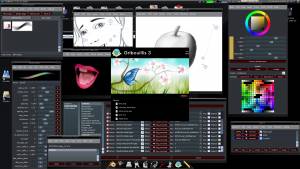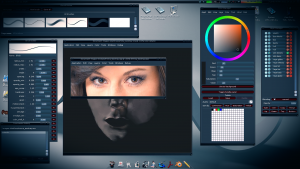Introduction
GB3 (Gribouillis version 3) is the third major version of my first try to make a higly portable painting program.
GB3 is a full re-write and better MVC design of the previous version (GB2).
Goals are:
- Highly portable
- Close to the host GUI toolkit
- Easy to modify
- Able to uses tablet specific features (pressure, tilt, …)
- Rich features like layers, undo/redo historic, multi-documents, and so on
To reach them GB3 uses following technologies:
- Python 2.5.x : (portability, easy modifications).
- PureMVC : (like python, gives a framework for a graphic application, virualize the GUI toolkit used).
- PyMUI : MUI Python binding (MorphOS)
- PyGTK : GTK+ Python binding (others platforms)
- PyCairo : (rendering, portability)
Targets
GB3 is designed to be simple: it's not (for the moment…) an image editor/manipulator. It takes some ideas seen since a long time on Amiga, but also on OS stamped modern, like Linux.
We'll find some similarities with following projects: ChibiPaint, DrawPile, FlowPaint, Krita, MyPaint and Qaquarelle.
Downloads and Installation
Current version is 3.1.500.
Grunch
GB3 as all my others programs is available under Grunch using my Grunch database.
Download it and install the file in directory <Grunch directory>/Database/User.
Grunch handles automatically for you all dependencies solving and installation!
Downloads
Dependencies
Gribouillis requires following dependencies:
- PyCairo, 1.8.2 (this is a MorphOS binary archive, official web site here)
Binaries
| Platform | URI | Size | MD5 |
|---|---|---|---|
| MorphOS-PPC | MUI view - v3.1.500 | 1.5 MB | a630177bcd5d19a29c5dfdef37acc405 |
Sources
Sources are available as snapshot of the same revision used to generate binaries releases.
Only if you know how to build it yourself (eg. for other another platforms) or for you information ![]() .
.
| Platform | URI | Size | MD5 |
|---|---|---|---|
| Any | Sources - v3.1.500 | 1.0MB | f93f6b49a96120fd6f2541a8662f6884 |
Credits
- GB3 icons/images from Christophe DELORME and Sébastien POEZL.
Licenses
- GB3 files (binaries/sources) are released under the MIT License.
- Some files in the stadnalone archive are distributed under their own licenses (Python, LGPL, etc). A license file is provided for them.
Bugs and limitations
(This category is only maintained for the current release and subject of changes).
General
- Waiting for your feedback!
PyMUI specific
- Waiting for your feedback!
PyGTK specific
- Where is the release!
Technical aspects
Portability
Numerous others supposed cross-platform projects fail to reach this goal due to miss-understanding of used technologies. This is mostly seen for applications using graphic user interfaces (GUI).
Almost cross-platform projects try to find a toolkit adapted to the application's main language. This portable toolkits are written to expose the most common denominator between native GUI toolkits on each system.
Unfortunately most of the time these toolkits differs largely from each one, causing troubles and difficulties to keep nice API interface and system-friendly aspect in the same toolkit.
Except the language used, this is one reason of existence of so many portable GUI toolkits.
Consequence of this, toolkits don't try to expand to much their portability and limit their native support.
And for thus that don't try (like WxWidgets) to limit, porting them is a nightmare and even official examples are littered with platform conditional blocks to make them work.
So is another solution exists?
I think yes, I've found my solution just by using a not so young software design pattern knowns as MVC.
The idea is to apply the MVC rules stricly: user interface (UI) is loosely coupled of the functionality.
MVC stands for Model-View-Controler: This is not a new thing in software development, but this concept was never be used in a whole to separate platforms UI backends (aka the GUI toolkits).
So now the overall design is chosen, remains to find the language: Python is a good candidate!
Why?
- Python tries to be multi-platforms and highly portable (even if I found its C implementation mostly designed for POSIX), and Python interpretor exists in many forms (C, Java, …).
- Most of native toolkits have their binding in Python.
- Python has a well documented C-API and the language is easily extensible using dynamic modules.
- It's a script language, modifications don't need recompilation from clever maintainers.
- An well-known simple MVC framework exists for Python: PureMVC.
Rich features
One of the main features of GB3 (other than it's true multi-platform design ![]() ) is to not put limit to the drawing surface: you can always grow your image in all direction, it's border-less (excepted when saving obviously).
) is to not put limit to the drawing surface: you can always grow your image in all direction, it's border-less (excepted when saving obviously).

